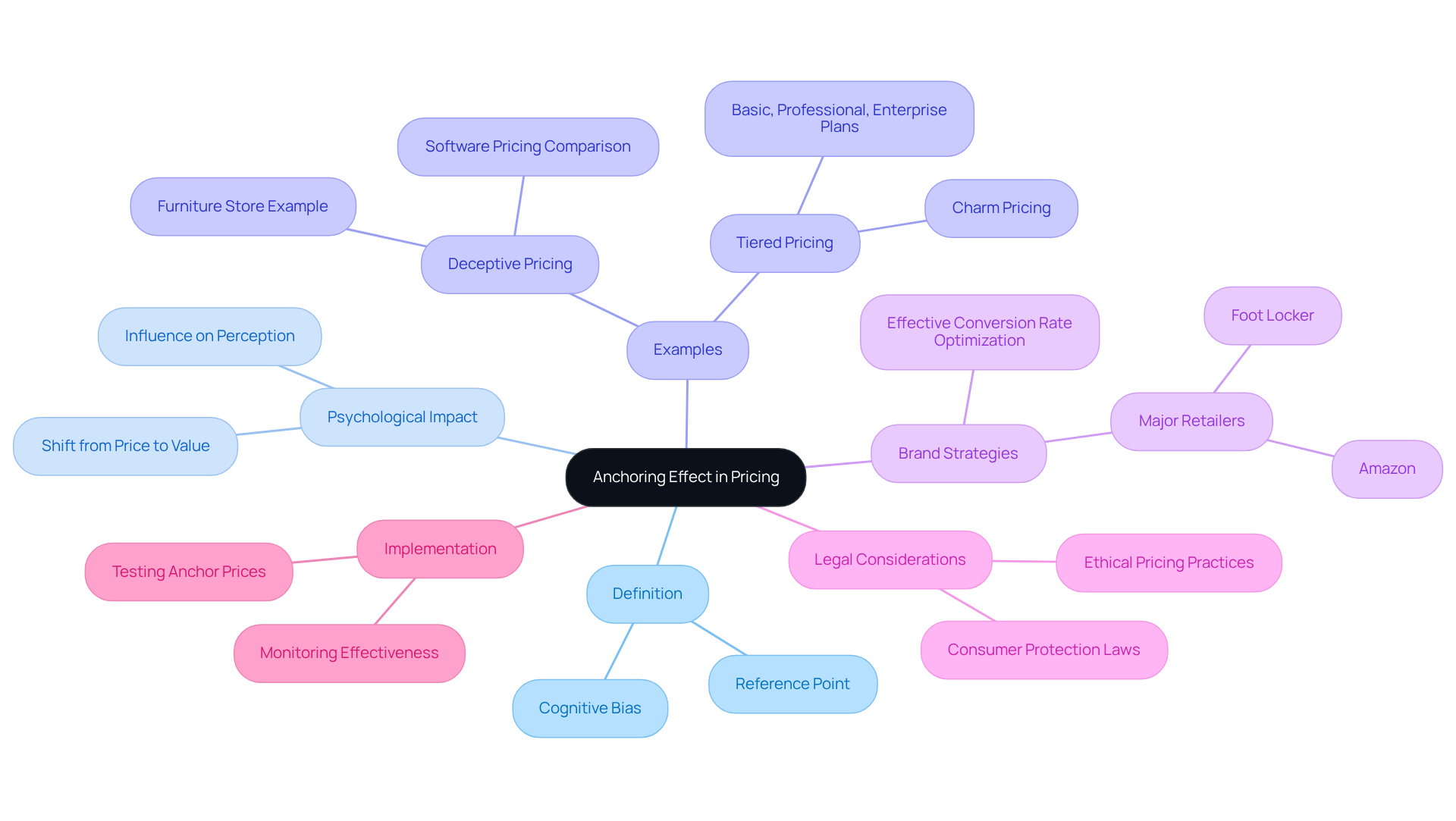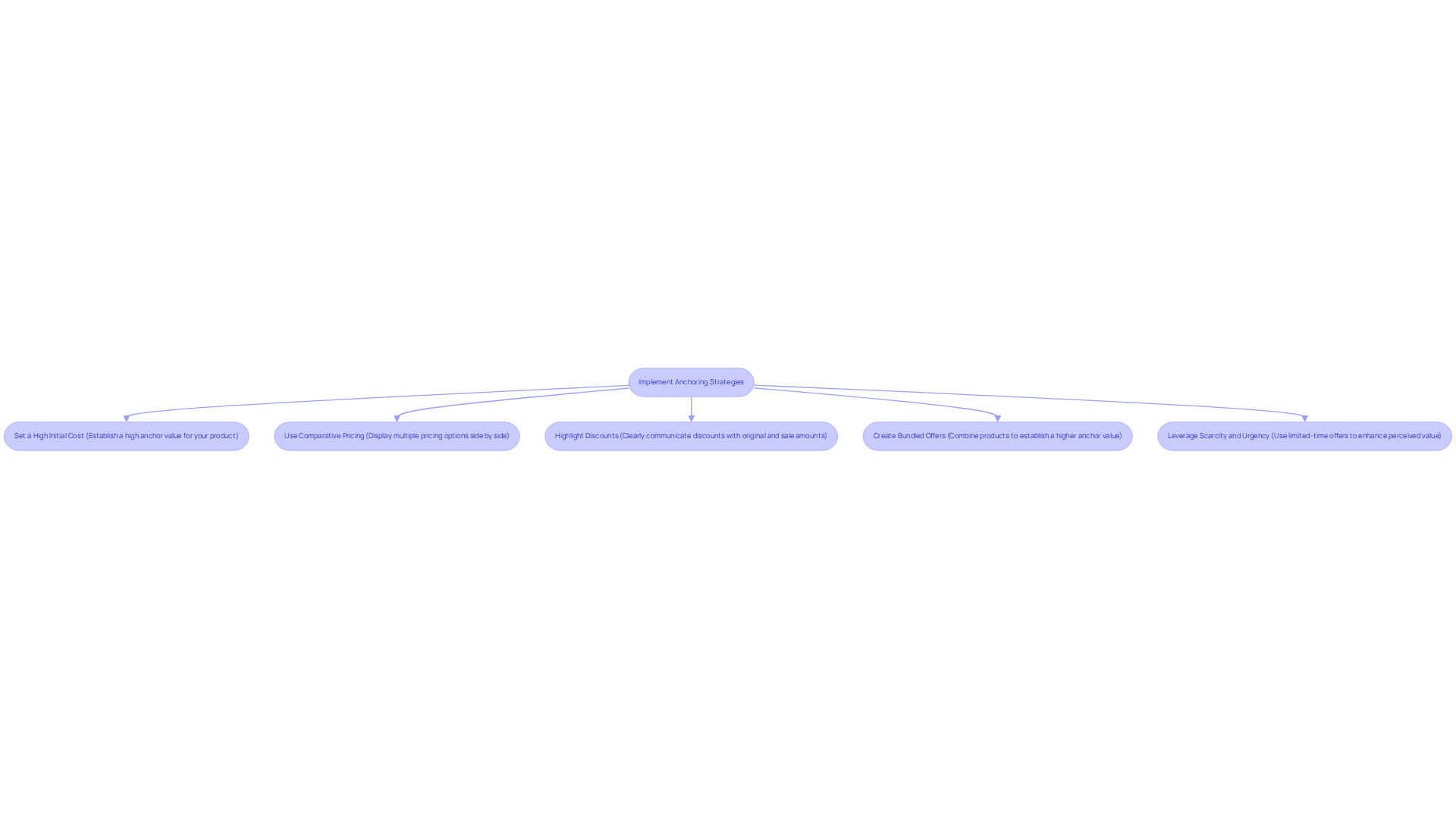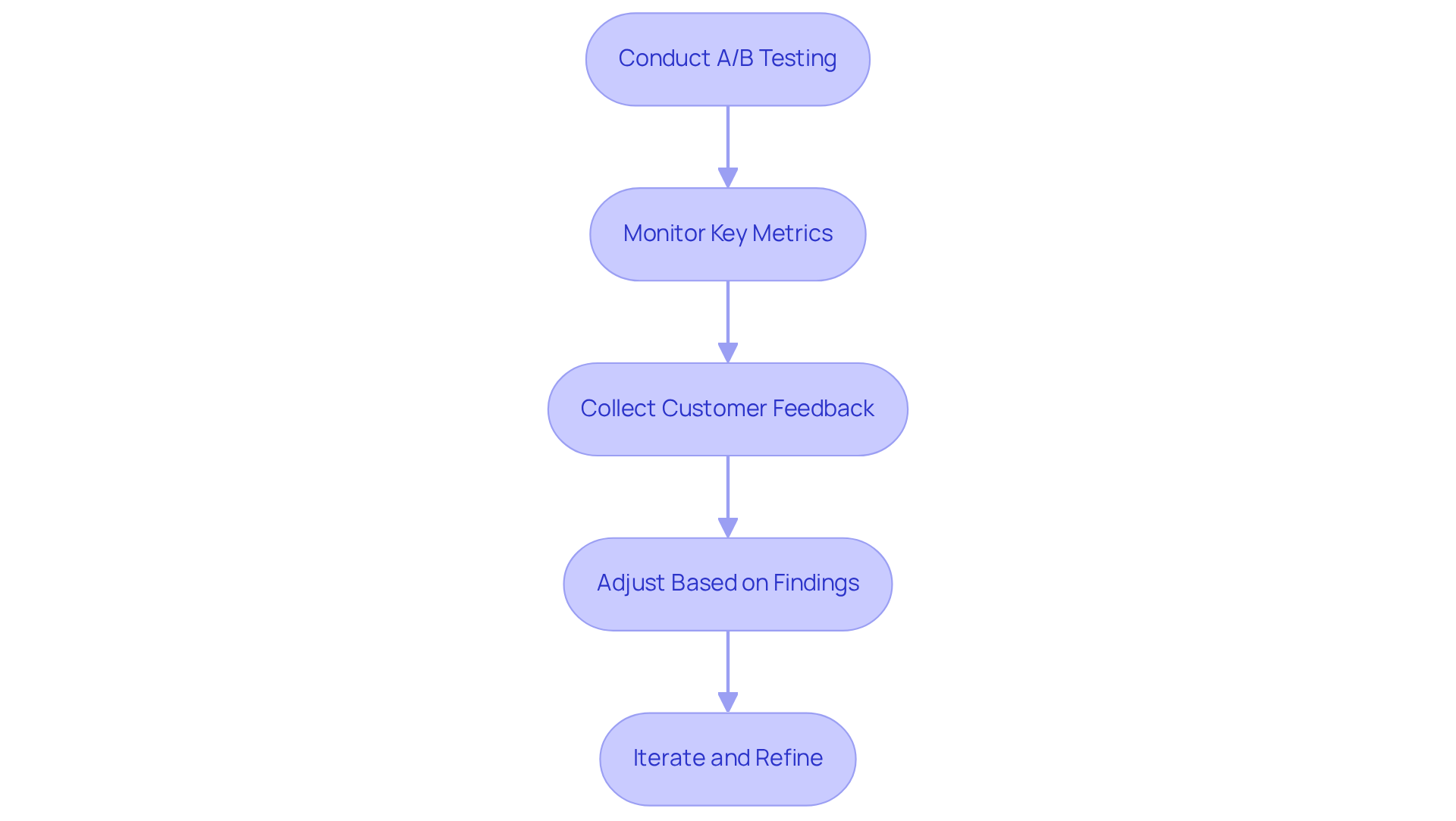
Overview
This article delves into the anchoring effect in pricing, illustrating how it can significantly elevate success for direct-to-consumer (DTC) brands. By expertly influencing consumer perceptions of value, this psychological phenomenon drives purchasing decisions. Key strategies such as:
- Setting high initial prices
- Employing comparative pricing
- Prominently highlighting discounts
are detailed. Each of these tactics leverages cognitive biases, ultimately improving conversion rates and increasing average order values. DTC brands that harness these strategies position themselves to not only attract attention but also foster a compelling desire among consumers to engage with their offerings.
Introduction
The anchoring effect in pricing serves as a formidable psychological tool that profoundly shapes consumer perceptions and influences purchasing decisions. By strategically establishing initial price points, brands can craft compelling reference points that enhance perceived value and drive sales. However, as direct-to-consumer (DTC) brands adopt these strategies, they encounter the challenge of balancing effective pricing with ethical considerations and consumer trust.
How can brands master the art of anchoring to not only elevate conversion rates but also cultivate long-term customer loyalty?
Understand the Anchoring Effect in Pricing
The anchoring effect pricing illustrates a significant cognitive bias that influences how individuals assess costs in relation to an initial reference point, often known as the anchor. For instance, when a product is first priced at $100 and subsequently offered at a discounted rate of $70, the original price serves as an anchor, rendering the discount more enticing. This psychological phenomenon redirects buyer attention from the absolute cost to the perceived value of the deal, thereby enhancing the attractiveness of the offer.
Research demonstrates that buyers often heavily depend on the first piece of information they encounter, profoundly influencing their purchasing decisions. Major retailers frequently leverage this strategy, with brands such as Foot Locker and Amazon employing deceptive discounts to foster a perception of savings. By establishing a clear anchor, these brands guide customers toward favorable purchasing decisions, ultimately improving conversion rates and average order values (AOV).
Real-world scenarios further exemplify the anchoring effect's impact on consumer behavior. For example, furniture stores may label a couch at $2,000 with a '50% off' sale price of $1,000, creating an illusion of value that propels sales. Similarly, software companies might present a $999/month plan alongside a $99/month plan, making the latter appear as a bargain. These tactics underscore how effective anchoring can drive increased sales and enhance profitability.
However, it is crucial for DTC brands to remain cognizant of the potential legal ramifications associated with misleading pricing strategies. Deceptive discounts can incur legal consequences in certain jurisdictions. Moreover, while tiered pricing structures can effectively steer customers toward a preferred option, brands must ensure that their anchor prices are credible and align with customer expectations to prevent skepticism.
Understanding is vital for DTC brands aiming to refine their pricing strategies. By harnessing anchoring effect pricing, brands can elevate perceived value, ultimately fostering improved customer engagement and higher conversion rates. At Parah Group, we focus on sustainable growth through expert Conversion Rate Optimization methods that not only enhance profitability but also adhere to ethical pricing practices, ensuring long-term success for DTC brands. Our onboarding process is designed to tailor our approach to your specific needs, enabling us to implement effective CRO strategies that deliver results.

Implement Anchoring Strategies to Enhance Pricing
To effectively implement anchoring strategies, consider the following steps:
- Set a High Initial Cost: Establish a high anchor value for your product or service. This could be the original price before a discount or a premium version of the product. For instance, if you sell a basic version of a product for $50, introducing a premium version at $100 creates a compelling reference point that enhances perceived value.
- Use Comparative Pricing: Display multiple pricing options side by side. Offering three versions of a product—basic, standard, and premium—ensures that the premium version is priced significantly higher. This strategy makes the standard version appear more attractive by comparison, effectively.
- Highlight Discounts: Clearly communicate discounts by displaying the original amount alongside the sale amount. For instance, if a product is reduced from $80 to $60, showcasing both amounts prominently highlights the savings, strengthening the value perception for customers.
- Create Bundled Offers: Combine products and establish a higher anchor value for the bundle. If individual items are priced at $20 each, offering a bundle of three for $50 positions the bundle as a better deal, leveraging the anchoring effect to drive sales.
- Leverage Scarcity and Urgency: Use limited-time offers or low stock alerts to enhance the perceived value of the anchor price. Creating a sense of urgency can prompt quicker purchasing decisions, as consumers are motivated by the fear of missing out on a good deal.
By applying these approaches, brands can effectively leverage the anchoring effect to improve their cost structures, ultimately resulting in increased conversions and higher average order values (AOV). [Parah Group's comprehensive approach to Conversion Rate Optimization](https://parahgroup.com) ensures that these anchoring strategies are supported by rigorous testing and alignment of marketing efforts, driving significant growth for DTC brands. For instance, companies like Organifi have successfully employed comparative pricing to position their products favorably against competitors, achieving a conversion rate of about 10%. Furthermore, the use of clear visual cues, such as strikethroughs on original prices, can significantly influence consumer perception and decision-making.

Test and Optimize Your Anchoring Strategies
To maximize the effectiveness of your anchoring strategies, it is essential to implement the following steps for rigorous testing and optimization:
- Conduct A/B Testing: A/B testing is crucial for assessing various cost strategies. For instance, compare two distinct anchor prices for the same product to identify which one demonstrates the effectiveness of anchoring effect pricing in yielding higher conversion rates. Analyzing these results will enable you to determine the cost structure that resonates most effectively with your audience.
- Monitor Key Metrics: Vigilantly monitor critical metrics such as conversion rates, average order value (AOV), and cart abandonment rates. Utilize analytics tools to gather insights on how changes in costs affect . This data will empower you to identify trends and make informed, data-driven decisions.
- Collect Customer Feedback: Engage in customer surveys to evaluate perceptions of your costs. Inquire about their views on anchor prices and whether they feel they are receiving good value for their purchases. This qualitative feedback can reveal insights that anchoring effect pricing may not capture in quantitative data.
- Adjust Based on Findings: Be ready to modify your cost strategies based on the insights gathered. If a specific anchor price underperforms, consider testing alternative price points or adjusting your comparative cost structure to optimize anchoring effect pricing.
- Iterate and Refine: Your pricing strategies should evolve continuously. Regularly iterate and refine your approach based on ongoing testing and customer feedback. Stay attuned to market trends and buyer preferences to ensure your costs remain competitive and effective.
By consistently testing and optimizing your anchoring strategies, you can align your pricing with consumer expectations and significantly enhance your conversion potential.

Conclusion
Understanding and implementing the anchoring effect in pricing strategies is paramount for the success of direct-to-consumer (DTC) brands. By effectively harnessing this psychological principle, brands can establish compelling reference points that not only enhance perceived value but also drive consumer decisions. The anchoring effect significantly influences how customers perceive savings and impacts their purchasing behavior, making it an indispensable tool for optimizing pricing.
Key strategies for leveraging the anchoring effect have been thoroughly discussed, including:
- Setting high initial costs
- Employing comparative pricing
- Highlighting discounts
- Creating bundled offers
- Instilling a sense of urgency
Each of these tactics manipulates consumer perception, guiding them toward more favorable purchasing decisions. Furthermore, the importance of testing and optimizing these strategies through A/B testing, monitoring key metrics, and collecting customer feedback has been emphasized to ensure ongoing effectiveness and alignment with consumer expectations.
Ultimately, the anchoring effect serves as a powerful mechanism for DTC brands to enhance their pricing strategies, improve conversion rates, and increase average order values. By adopting ethical practices and continuously refining their approaches, brands can achieve not only short-term sales goals but also foster long-term customer loyalty. Embracing these insights and techniques can lead to significant growth and sustained success in a competitive market.
Frequently Asked Questions
What is the anchoring effect in pricing?
The anchoring effect in pricing is a cognitive bias that influences how individuals evaluate costs based on an initial reference point, known as the anchor. For example, if a product is initially priced at $100 and later offered at $70, the original price serves as an anchor, making the discount seem more appealing.
How do retailers use the anchoring effect to influence buyers?
Retailers often use the anchoring effect by presenting an original price alongside a discounted price to create a perception of savings. This strategy shifts buyer focus from the actual cost to the perceived value of the deal, enhancing the attractiveness of the offer.
Can you provide examples of the anchoring effect in real-world scenarios?
Yes, one example is furniture stores that label a couch at $2,000 with a '50% off' sale price of $1,000, creating an illusion of value. Another example is software companies presenting a $999/month plan next to a $99/month plan, making the latter appear as a bargain.
What are the potential legal implications of using deceptive discounts?
Deceptive discounts can lead to legal consequences in certain jurisdictions, so brands must be cautious when implementing misleading pricing strategies to avoid legal issues.
How should DTC brands approach anchoring effect pricing?
DTC brands should ensure that their anchor prices are credible and align with customer expectations to avoid skepticism. By effectively utilizing anchoring effect pricing, brands can increase perceived value, improve customer engagement, and enhance conversion rates.
What is the significance of ethical pricing practices in anchoring effect strategies?
Ethical pricing practices are essential for sustainable growth and long-term success. Brands should focus on enhancing profitability while adhering to ethical standards to maintain customer trust and avoid legal repercussions.
FAQs











